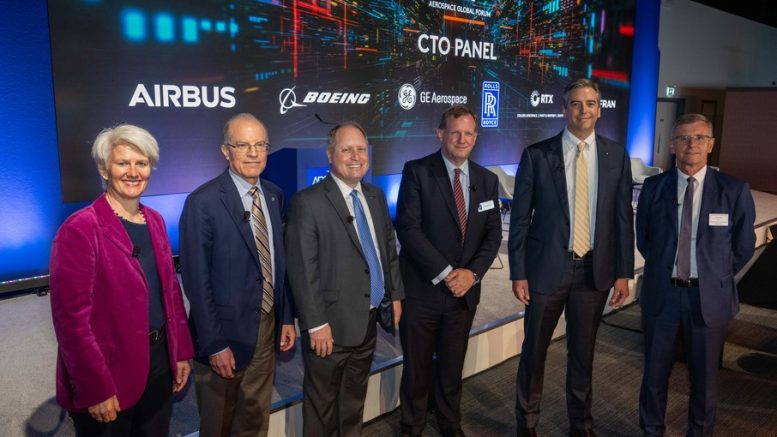As Chief Technology Officers representing organizations across the industry, we fully support the civil aviation industry’s commitment to achieve net zero CO2 emissions by 2050.
At the Paris 2023 Air Show, we highlighted the importance of the production, distribution, and uptake of qualified Sustainable Aviation Fuels (SAF), advanced aircraft and propulsion technologies, and improved aircraft operations for achieving net zero CO2 emissions.
To address the full climate impact of aviation, the sector is also accelerating efforts critical to understanding and reducing aviation’s non-CO2 effects including from nitrogen oxides (NOx), sulfur, aerosols, soot and contrails.
In collaboration with research institutions, universities and other key stakeholders, our industry is actively working on multiple large-scale projects and research programs aiming at improving the understanding of non-CO2 emissions and their impact on the climate, which could enable mitigation solutions from fuels, engine technology and flight operations.
Efforts such as FAA-ASCENT and CLEEN, SESAR projects such as CICONIA, Airbus led ECLIF3 and VOLCAN, and the Boeing
ecoDemonstrator Explorer projects include significant research and flight test campaigns across both Europe and North America.
A key part of non-CO2 emissions from aviation, persistent contrails are estimated to have a warming climate impact. Several scientific studies1 have sought to quantify their climate impact, but estimates are highly uncertain based on limited understanding of the physical and chemical properties and mechanisms, as well as atmospheric conditions, that influence contrail formation and evolution. Similarly, NOx emissions and their secondary reactions depend on engine design, operating conditions, and atmospheric conditions. Research and collection of data is essential to accurately quantifying the interactions and impacts of non-CO2 emissions.
Tuesday, July 23, 2024, Farnborough, UK
Joint Statement from Chief Technology Officers Advocating for Advancing Science on Aviation’s Non-CO2 Impacts on Climate Change
We jointly call for increased research funding to develop the science needed to underpin technology choices, operational changes and policy decisions. We will continue to engage academia, the global climate and weather modeling community, government research organizations and industry partners to advance seven priorities for research:
- Improve understanding of contrail formation, persistence, and climate impact. Progressing the science of contrail physics combined with increasing the fidelity of upper tropospheric humidity data in global climate and weather modeling will enable more accurate contrail forecasts and analysis data sets for performing impact assessment.
- Improve understanding of emissions properties. The properties offuels such as conventional jet fuel, SAF, and hydrogen as well as the combustion characteristics of engine technologies impact emissions properties that play a role in contrail formation and persistence.
- Build research on aerosol cloud interactions. Aerosol cloud interactions result from the ability of aerosol particles to cause the formation of droplets or ice particles, affecting the radiative properties of clouds. Research is required to better understand these interactions and their potential impacts.
- Improve understanding of the radiative impact and modeling uncertainty of NOx emissions. The effect of NOx emissions depends on where and when emissions are released into the atmosphere as well as atmospheric conditions.
Further studies are needed to fully characterize these dependencies. - Improve understanding of the interdependencies and trade-offs of aviation emissions (NOx, soot, contrails, CO2, and noise). To enable management of aviation emissions for total climate impact reduction, the challenges of comparing impacts across emissions species with different characteristics and interactions need to be addressed.
- Establish and improve common models for quantifying the effect of aviation on climate. Collaboration across communities working on contrails and cloud physics, atmospheric chemistry, fuels properties and chemistry, and aircraft data collection to support this research is essential and can benefit climate science and weather prediction.
- Research on airspace network impacts of mitigation should be further investigated. Large scale research projects and operational analysis should be developed to better understand potential impacts to civil airspace operations.
As the industry aims to mitigate the impact of non-CO2 emissions, we are unified in focusing our efforts on research, flight testing and data transparency to advance these seven priorities alongside our academic and government stakeholders. Through industry, academic and institutional stakeholders effectively working together, we can achieve meaningful progress toward a more sustainable aviation industry.
Signed by, Sabine Klauke, Chief Technology Officer Airbus
Chris Lorence, Chief Engineer GE Aerospace
Juan M. de Bedout, Chief Technology Officer RTX
Gérard Leflour, Chief Technology Officer Dassault Aviation
Todd Citron, Chief Technology Officer The Boeing Company
Simon Burr, Group Director of Engineering, Technology and Safety Rolls-Royce
Eric Dalbiès EVP, Strategy and Chief Technology Officer Safran





Be the first to comment on "Commitment to achieve net zero CO2 emissions by 2050"